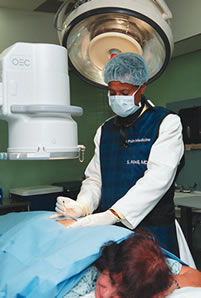School of Medicine Department Heads to the
Top with New Innovations
Expanding Anesthesiology
![]()
teady breathing and stable vitals in the operating
room offer assurance to both surgeon and anesthesiologist, but what happens
when this delicate balance is suddenly lost? Training students and faculty
in unexpected obstacles, the new Patient Safety Center simulates real
world scenarios in the OR and is just one of many exciting initiatives
underway in the Department of Anesthesiology, Perioperative Medicine,
and Pain Management.
 |
||
 |
||
“We’re moving from merely training to team building, crisis management, and error prevention,” says David Lubarsky, M.D., M.B.A., department chairman. Beginning with the recruitment of Lubarsky from Duke University in 2001, the Department of Anesthesiology has grown exponentially at the School of Medicine, supported by a team of faculty and staff as dynamic and enthusiastic as its leader.

Lubarsky’s first step in moving his department to the nation’s top tier was gathering the personnel to help achieve that goal. Reaching out across the country, the medical school recruited some of the field’s masters, including Paul Barach, M.D., M.P.H., from the University of Chicago, who will direct the Patient Safety Center. David Birnbach, M.D., joined the department from Columbia University to serve as executive vice chair and associate director of the Institute for Women’s Health, bringing international renown in obstetric anesthesia.
Also on board is Salahadin Abdi, M.D., Ph.D., recruited from Harvard University to direct the Pain Center. “Anesthesiologists originally managed pain intraoperatively,” Abdi says. “But physicians have come to realize that pain treatment has to be optimized after surgery, too, in order to achieve the best patient outcomes satisfaction. We are committed to lending our expertise to help achieve that.” The center also provides state-of-the-art care for outpatients with chronic pain.
The Department of Anesthesiology is also branching out to provide unique opportunities for all School of Medicine faculty. Using his training from Duke’s Fuqua School of Business, Lubarsky encourages physicians to embrace the clinical enterprise and strive for excellence in patient care and administration. In addition to early exposure to anesthesiology in the curriculum and dedicated fellowships and internships, he is collaborating with Paul Sugrue, Ph.D., M.B.A., dean of the School of Business Administration, to establish the nation’s first business elective for fourth-year medical students. The medical school also is working with the business school in planning a mini-M.B.A. program for faculty physicians.
“We want to build bridges between departments, schools, and across the University,” Lubarsky says. “UM will be the showcase for these types of initiatives.”